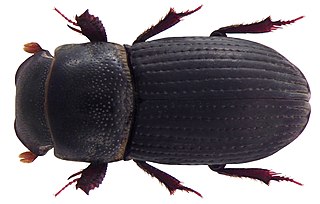
Dung beetles are beetles that feed on feces. Some species of dung beetles can bury dung 250 times their own mass in one night.

The scarab beetle subfamily Scarabaeinae consists of species collectively called true dung beetles. Most of the beetles of this subfamily feed exclusively on dung. However, some may feed on decomposing matter including carrion, decaying fruits and fungi. Dung beetles can be placed into three structural guilds based on their method of dung processing namely rollers (telecoprids), dwellers (endocoprids) and tunnelers (paracoprids). Dung removal and burial by dung beetles result in ecological benefits such as soil aeration and fertilization; improved nutrient cycling and uptake by plants, increase in Pasture quality, biological control of pest flies and intestinal parasites and secondary seed dispersal. Well-known members include the genera Scarabaeus and Sisyphus, and Phanaeus vindex.

Melolonthinae is a subfamily of the scarab beetles. It is a very diverse group; distributed over most of the world, it contains over 11,000 species in over 750 genera. Some authors include the scarab subfamilies Euchirinae and Pachypodinae as tribes in the Melolonthinae.

Aphodius is a genus of beetles in the family Scarabaeidae. In most species both the adults and larvae are coprophagous although some species have herbivorous or saprophagous larvae. Aphodius species typically dominate dung beetle communities in north temperate ecosystems. Most species are functionally classified as endocoprids, also known as dwellers, because the larvae live and feed within the dung pat itself.

Cartwrightia is a genus of scarab found in Latin America. It was named and circumscribed in 1958 by Federico Islas Salas. As of 2017, three species are recognized: C. intertribalis, C. cartwrighti, and C. islasi. They can be found in the nests of leafcutter ants or in dung.
Xeropsamobeus asellus is a species of aphodiine dung beetle in the family Scarabaeidae. It is found in the United States and Mexico, although other sources consider it endemic to Texas.

Phanaeini is a tribe of dung beetles in the family Scarabaeidae. There are about 12 genera and 200 described species in Phanaeini. They are native to the Americas with the highest species richness in the Neotropics. They are mostly coprophagous or necrophagous, but some of the least known genera appear to be myrmecophilous. They are medium-sized to large beetles, often with bright metallic colors, and often with horns on their heads.

Eupariini is a tribe of aphodiine dung beetles in the family Scarabaeidae. There are more than 40 genera and 640 described species in Eupariini.

Leiopsammodius is a genus of aphodiine dung beetles in the family Scarabaeidae. There are more than 40 described species in Leiopsammodius.
Haroldiataenius is a genus of aphodiine dung beetles in the family Scarabaeidae. There are about nine described species in Haroldiataenius.
Odontolytes is a genus of aphodiine dung beetles in the family Scarabaeidae. There are about 19 described species in Odontolytes.
Aidophus is a genus of aphodiinae dung beetles in the family Scarabaeidae. There are about 12 described species in Aidophus.
Euparia is a genus of aphodiine dung beetles in the family Scarabaeidae. There are about six described species in Euparia.
Parataenius is a genus of aphodiine dung beetles in the family Scarabaeidae. There are about six described species in Parataenius.

Dialytes is a genus of aphodiine dung beetles in the family Scarabaeidae. There are about five described species in Dialytes.
Odontopsammodius is a genus of aphodiine dung beetles in the family Scarabaeidae. There are about 12 described species in Odontopsammodius.
Hornietus is a genus of aphodiine dung beetles in the family Scarabaeidae, the sole genus of the tribe Hornietiini. There is one described species in the genus, Hornietus ventralis, found in North America.
Martineziana is a genus of aphodiine dung beetles in the family Scarabaeidae. There are about six described species in Martineziana.

Rhyparini is a tribe of scarab beetles in the family Scarabaeidae. There are about 14 genera and more than 120 described species in Rhyparini.















